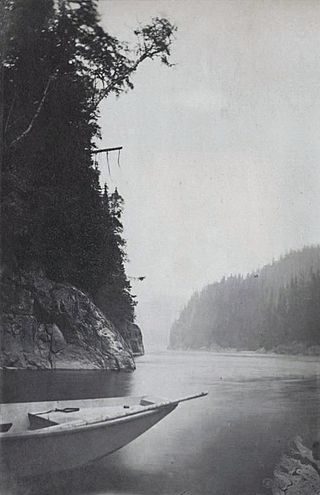
The Magpie River is a 200-kilometre (120 mi) river in the Côte-Nord region of Quebec which flows from the Labrador Plateau to empty into the north shore of the Saint Lawrence River east of Sept-Îles, Quebec. Since 2008 the Magpie Generating Station has been generating electricity. In 2021, the local municipality of Minganie and the Innu Council of Ekuanitshit decided to grant the Magpie River legal personhood in order to protect it long term, given its appeal for energy producers like Hydro-Quebec and Innergex Renewable Energy.

The Natashquan is a river in the Canadian provinces of Quebec and Newfoundland and Labrador. It flows south into the Gulf of Saint Lawrence.
The Zec de la Rivière-Moisie is a "zone d'exploitation contrôlée" (ZEC) in the city of Sept-îles in Sept-Rivières Regional County Municipality (MRC), in the administrative region of North Shore, in Quebec, in Canada.

The rivière au Tonnerre is a watercourse that runs through the municipality of Rivière-au-Tonnerre, Quebec in the Minganie Regional County Municipality (RCM), in the Côte-Nord administrative region, in Quebec, in Canada. The course of the river crosses the township of Margane, then constitutes the boundary between the townships of Margane and Touzel until the confluence of the river with the North shore of the Gulf of Saint Lawrence.
Lake Nipisso is a 40 square kilometres (15 sq mi) lake in a remote part of the Côte-Nord region of Quebec, Canada.

The Moisie River Aquatic Reserve is a proposed protected area in the Côte-Nord region of Quebec, Canada. It would protect the waters and surrounding lands of the 363 kilometres (226 mi) Moisie River. The Moisie is one of the largest rivers in the region, flows through dramatic unspoiled scenery and is an important Atlantic salmon river. Although the plan to create the reserve was announced in 2003, as of 2018 the local Innu communities had yet to give their consent.
The Aux Pékans River is a river in the Côte-Nord region of Quebec, Canada. It is a tributary of the Moisie River. Hydro-Québec caused controversy in the early 1990s by proposing to divert the river to supply the reservoir of the SM-3 power plant on the Sainte-Marguerite River.
Carheil Lake is a lake in the Côte-Nord region of Quebec, Canada. It is just south of Fermont, and is the source of the Carheil River, which runs south to the Aux Pékans River. The lake has been polluted with phosphorus from wastewater effluent from Fermont, causing algal bloom. This is cause for concern since the lake is among the headwaters for the wild and unspoiled Moisie River.
The Olomane River is a river in the Côte-Nord region of Quebec, Canada.

The Saint-Jean River is a major tributary of the north shore of the Gulf of St. Lawrence, flowing in the unorganized territory of Lac-Jérôme and in the municipality of Rivière-Saint-Jean, in the Minganie Regional County Municipality, in the administrative region of Côte-Nord, in the province of Quebec (Canada). It is considered one of the three salmon rivers on the North Shore.
The Véronique River is a river in the Côte-Nord region of the province of Quebec, Canada. It flows into the Gulf of Saint Lawrence, opposite to Anticosti Island.

The Piashti River is a salmon river in the Côte-Nord region of the province of Quebec, Canada. It empties into the Gulf of Saint Lawrence.

The Chaloupe River is a 32 kilometres (20 mi) river of the Côte-Nord region of Quebec. It flows from north to south and empties into the Gulf of Saint Lawrence.

The Sheldrake River is a river in the Côte-Nord region of Quebec, Canada. It flows into the Gulf of Saint Lawrence. There is a 25 MW hydroelectric power station on the river.

The Pashashibou River is a river in the Côte-Nord region of Quebec, Canada. It flows into the Gulf of Saint Lawrence.

The Matamec River is a salmon river in the Côte-Nord region of Quebec, Canada. It empties into the Gulf of Saint Lawrence. The river was used for research into Atlantic salmon and brook trout by the Woods Hole Oceanographic Institution (WHOI) between 1966 and 1984. Today the southern part of the watershed is strictly protected by the Matamec Ecological Reserve..
The Rapides River is a river in the Côte-Nord region of Quebec, Canada. It empties into the Gulf of Saint Lawrence.
The Dominique River is a river in the Côte-Nord region of Quebec, Canada. It empties into the Gulf of Saint Lawrence.
The Saint-Paul River is a river on the Labrador Peninsula of eastern Canada. Its source is located in the province of Newfoundland and Labrador and it empties into the Gulf of Saint Lawrence in the Côte-Nord region of Quebec. The Saint-Paul River is a salmon river that flows in a southerly direction.

The Saint-Augustin River is a salmon river in the Côte-Nord region of Quebec, Canada. It empties into the Gulf of Saint Lawrence.













